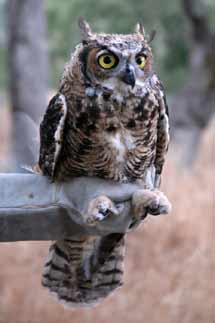
Handy Links
SLAC News Center
SLAC Today
- Subscribe
- Archives: Feb 2006-May 20, 2011
- Archives: May 23, 2011 and later
- Submit Feedback or Story Ideas
- About SLAC Today
SLAC News
Lab News
- Interactions
- Lightsources.org
- ILC NewsLine
- Int'l Science Grid This Week
- Fermilab Today
- Berkeley Lab News
- @brookhaven TODAY
- DOE Pulse
- CERN Courier
- DESY inForm
- US / LHC
SLAC Links
- Emergency
- Safety
- Policy Repository
- Site Entry Form

- Site Maps
- M & O Review
- Computing Status & Calendar
- SLAC Colloquium
- SLACspeak
- SLACspace
- SLAC Logo
- Café Menu
- Flea Market
- Web E-mail
- Marguerite Shuttle
- Discount Commuter Passes
-
Award Reporting Form
- SPIRES
- SciDoc
- Activity Groups
- Library
Stanford
Around the Bay
The Bird has Flown
 The great horned owlet that fell to the ground from End
Station B in April was successfully released into the wild Saturday night from
SLAC grounds. (See original SLAC Today story
here.) The chick was part of a brood that nested on a high ledge in
February. The owlet was not injured, but could not return to the nest. Normally
the parents would fly down and feed a dislocated nestling, but timing coincided
with demolition of the Final Focus Test Beam facility and the scaled-up
industrial activity blocked the owlet from finding suitable shelter out of the
nest.
The great horned owlet that fell to the ground from End
Station B in April was successfully released into the wild Saturday night from
SLAC grounds. (See original SLAC Today story
here.) The chick was part of a brood that nested on a high ledge in
February. The owlet was not injured, but could not return to the nest. Normally
the parents would fly down and feed a dislocated nestling, but timing coincided
with demolition of the Final Focus Test Beam facility and the scaled-up
industrial activity blocked the owlet from finding suitable shelter out of the
nest.
Wildlife Rescue took the owlet on April 16, where it spent two months in rehab with two adult males acting as surrogate parents. In early June it was moved to a larger cage until it demonstrated that it could catch wild mice.
Mike Scharfenstein, LCLS safety coordinator and avid birder, suggested two possible release sites to the owl's handlers. The first location, on the south side of the research yard, had suitable open space and dense clusters of trees. But between the 280 freeway and industrial buildings, that location seemed "just a little close to everything," as Wildlife Rescue volunteer Karen Hoyt put it. The second location, the picnic area between the linac and Jasper Ridge where the owl was finally released, offered more habitat and less human activity.
Lisa Konie, the Wildlife Rescue volunteer who for the past three weeks kept the owl in a 40-foot cage in her backyard, took a small, bright yellow box from her truck. She donned long leather gloves and, after a scuffle, brought out the young owl. With Konie clutching the owl's legs just above its talons, the bird looked around calmly. "They know when you have control," Konie explained.
Moments later the call of another great horned owl broke the quiet. A fledgling, its "horns" still just nubs, was perched nearby on the fence. Hoyt took that as a great sign. While great horned owls typically require about a ten-mile radius of habitat, they are social birds. The older owl "will revert to baby talk" with the younger one, said Hoyt.
As Konie released the owl, it flew straight over the fence, under the power lines stretching across the reserve, and disappeared into the valley.
"She's sitting in a tree going 'wow, no walls,'" Hoyt said after watching the owl fly away through her binoculars.
The owlet will sit for a long time as it acclimates, explained Konie, but it seemed to settle into its new environment encouragingly quickly. The bird was tagged with a leg band and will be identifiable over the coming years.
Image: The great horned owlet that fell from End Station B in April and was released at SLAC Saturday night. Click image for larger version. See more photos here.
—Krista Zala
SLAC Today, July 3, 2006